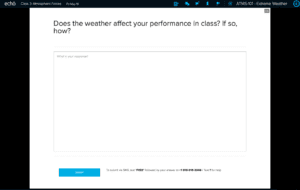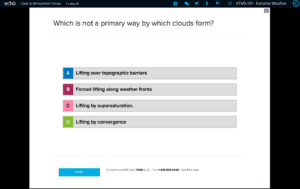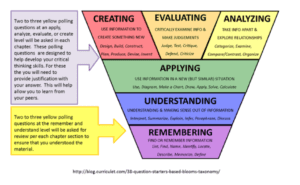Formative Assessment: Creating Assessments for Learning

We hear it more and more as we support students to become lifelong learners and shift the focus from learning content to learning experience, ‘assessment FOR learning versus assessment OF learning.’ Since Michael Scriven used the terms formative and summative assessment in 1967 to differentiate between goals for assessment and how the information is used, interest in the impact of formative assessment on learning has grown and been redefined numerous times.
The Role of Formative Assessments
In his book, Transformative Assessment (2008), W James Popham defines formative assessment as “a planned process in which assessment-elicited evidence of students’ status is used by teachers to adjust their ongoing instructional procedures or by students to adjust their current learning tactics.”
This definition clearly reminds us that effective formative assessment is as much about the student’s meta-cognition as it is about the instructor adjusting their practise to meet the needs of students. It is too late when a student fails a course to think about what they needed to do to pass. If one of the key purposes of higher education is to equip students to become lifelong learners then using formative assessment can only be seen as a beneficial tool to:
- increase student engagement
- identify students ‘at risk’
- teach students ways of thinking that will be beneficial in a course
- support them to become self-regulated learners
Acknowledging the current pressure on instructors to take on larger classes and to focus on their own research to ensure funding, a focus on formative assessment can feel like one more thing to worry about. However, the potential slowing down of instruction can mean gains elsewhere in a course (think less office hours, targeted higher level instruction and less time spent reciting content students already know), and new technology such as Echo360 can engage students with interactive polls and quizzes. Echo360 provides an opportunity to insert activities within videos or presentations that give instructors an opportunity to check in with students on their learning or to provoke classroom discussion.
The polls and quizzes in echo360 include:
- Multiple choice
- Image quizzes
- Short answer
- Ordered lists and
- Numerical activities
Echo360 also offers the opportunity for students to justify their answers if needed and the real time analytics also provide opportunities for prompt changes to instruction, even during that same class if necessary. What a time saver! As Dr. Stephanie Cole, Associate Professor at University of Texas Arlington, says, “Echo360 is a system that inspires critical thinking” by encouraging students to fully engage with the content they are learning.
One of the concerns that has been expressed to me about polls and quizzes is that they only require students to give answers using lower order cognitive skills like remembering facts and demonstrating understanding. I don’t agree.
If you are using short answer, multiple choice or image quiz questions, the questions you ask can offer students the opportunity to:
- Think critically
- Be creative
- Problem solve and,
- Think outside the box
As the instructor you get the chance to be both more engaging and learn something about your students. It’s about forming the right questions to get the most of the opportunity.
The Importance of Asking the “Right” Questions
To help consider the importance of the question, let’s take it outside of the classroom and imagine you’re at a cocktail party and a stranger approaches, introduces himself and then asks, “What do you do for a living?” A little later, another stranger approaches, introduces himself and says, “Tell me about your favourite moment with John, our host.”
Which of your new friends gets the most information from you?
Usually, the person able to ask the most open-ended questions gets the best conversation and learns the most. Finishing a conversation with me and knowing that I work in education isn’t anywhere near as interesting as learning that I met the host when I accidentally skied into the snow-boarding pipe, terrified myself and couldn’t get out until he helped me.
Open-ended questions help build relationships as they encourage responders to share their view of the world, knowledge and even feelings; you often learn something unexpected.

Learning something unexpected is also a highly useful effect of using open-ended questions with students. It can be easy to fall into the habit of asking only closed questions (yes/no, one word answers) to check that students have the content you want them to have. (lower order thinking).
Closed questions have an important role in our classes to give us a quick way to ensure that students are on track with content. They are also easier and faster for students to answer while giving us a quick overview. If I want to ensure that my students have learned the basics before moving on to more advanced concepts, a few closed questions can easily give me that information.

Remembering that a key purpose of higher education is to create life-long learners, it is imperative that they have opportunities to problem solve, think critically and think outside the box. An open-ended question offers more opportunity for students’ to share their view of the world, ideas and even concerns.
Well written multiple choice questions also offer opportunities for higher order thinking and peer instruction and collaboration. The challenge is the time it can take to write them. That said, as with many things in education, if done properly, they stand the test of time and may be reused with simple tweaks. Not only that, the information you can glean can also save you time in the long run.
A great resource Brame,c., (2013) Writing good Multiple Choice Questions can be found online.
Echo360’s analytics help you to immediately know which of your students participated, answered your questions, which questions were most effective compared to your objectives, which questions lead to unexpected answers, which questions encourage participation. and where there were gaps in knowledge.
Bloom’s Taxonomy and Formative Assessment
One of the most shared and used bases for cognitive development remains Bloom’s Taxonomy. Originally created in 1956 by a team that was led by Benjamin S Bloom, the Taxonomy was developed as a hierarchical model with six cognitive levels of complexity. Google Bloom’s Taxonomy and you will see links to many Universities and visual representations; it is the revised Bloom’s taxonomy (Anderson and Krathwohl, 2001) that instructors are referring to when they talk about lower order and higher order thinking.
Throughout the Echo360 student interface, the tools offer students the opportunity to work within both lower and higher order thinking. For example, the Q&A button offers students the opportunity to think creatively and share that with their peers, they can ask questions that demonstrate that not only are they learning, but they are also beginning to make judgements on the learning that may create a whole new set of theories. The polls and quizzes that you, as instructor, choose to use offer even greater scope.
When Dr Kjerstin Owens at Trocaire College wanted to increase student participation online and develop their critical thinking skills, she incorporated interactive activities and peer learning exercises into the course based on the taxonomy.
Students in the class reported that they were engaged by the variety of questions as they were both helpful to the learning and fun. Just as important, they provided data on the students participation and progress that Dr Owens could then use to reach out to students that may have been at risk. Formative assessment is ‘assessment for learning’ which has clearly made a difference at Trocaire.

To learn more about how to implement Echo360 at your institution fill out our contact form to be contacted by a Manager of Academic Partnerships.

